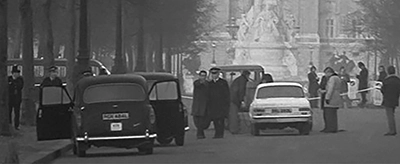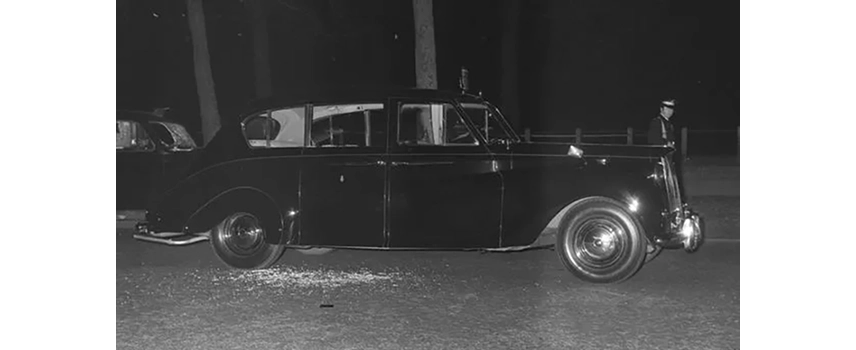Princess Anne Kidnap Attempt in 1974
“One man armed with two pistols, hancuffs and Valium tranquilizers came close to kidnapping a Princess”
by Alex Bomberg | 8th August 2019

The Mall, London, March 20th 1974, around 8pm
The 1974 attempted kidnapping of HRH Princess Anne shocked the world. The very simple plan by a lone-wolf attacker came very close to succeeding and might very well have done if it were not for chance. On the evening of the 20th of March 1974, HRH Princess Anne and her then husband Captain Mark Phillips were traveling back to Buckingham Palace in a chauffeur driven maroon Austin Princess mark IV, after an evening at a well publicised charity event on Pall Mall, a stone’s throw from the Palace.
Note: the vehicle the Royal couple were travelling in is wrongly described as being a Rolls Royce in some publications. It was a Austin Princess mark IV. John Lennon owned one and they were very popular at the time. The 1969 Austin Princess Vanden Plas Limousine, registration NGN 1 is now at the Sandringham Museum, in Norfolk, England. The vehicle was one of two purchased by the Royal household. The other car, its twin is said to now be in private hands.
There were five persons ravelling in the car with the Royal couple who were Inspector James Beaton, Princess Anne’s Royalty Protection Officer, Alex Callender the chauffeur and Rowena Brassey, the Princess's Lady-in-waiting.
Inspector James Beaton had joined the Police in 1962 and been with the Princess since the previous November, having joined the Royalty Protection Squad in March 1973.
There were no radio communications in the vehicle. In an interview some 40 years later, Beaton said that “a radio would have meant a lot of aerials and on a Royal car it was deemed that it would spoil the look of it”.
The Princess was 23 at the time of the incident and had married Captain Mark Phillips just five months before, in November 1973.
In a televised interview given a few years later to Michael Parkinson on ‘Parkinson in Australia’, the Princess when into great detail about the attempted kidnapping.
The exact timeline of the attempted kidnapping of Princess Anne are not 100% clear, but in the Princess’s own estimation the whole incident took place over a 10-15-minute period at around 8pm.
The Princess recalled being driven down the Mall, the road that serves as a ceremonial drive to Buckingham Palace, it was not very well lit, when a white Ford Escort car swerved in front and abruptly stopped.
Alex Callender, the chauffeur, stopped the vehicle and the Royal Protection Officer Inspector James Beaton got out of the vehicle. By this time the occupant of the white Ford Escort, Ian Ball had made his way out of the Escort and to the rear of the Princess’s vehicle. Inspector Beaton saw a firearm, a revolver and shots were then fired. Beaton had managed to get off a single shot from his own personal weapon, a Walther PPK semi-automatic pistol, Ball had managed to shoot and injured Beaton, with a number of shots smashing through the rear window of the Princess’s vehicle.
At this point, Alex Callender, the chauffeur, tried to exit the vehicle but he was then shot and slumped back in his seat.
Princess Anne recalls having a “discussion” with Ball, where he was telling her "come with me for a day or two" until he had secured a ransom. The Princess who is well-known for being feisty was having none of it and the argument continued for some time, adding "Not bloody likely and I haven't got £2 million”. She remembered trying to stay calm and trying to be polite to Ball. The Princess told Police at the time: “I kept saying I didn’t want to get out of the car, and I was not going to get out of the car”.
Inspector Beaton tried to shoot at Ball but was struggling due to his chest wound. He continued to try but his weapon jammed.
A newspaper journalist called Brian McConnell had been travelling in a black London Cab down the Mall when he had heard gunshots. McConnell ordered his cab driver to stop his cab, running back up the Mall to confront the gunman Ball.
McConnell is reported to have said to Ball "You can't do that. These are my friends. Don't be silly. Just give me the gun." Ball shot McConnell once in the chest, telling him to “get out of the way”. Police Constable Michael Hills by chance happened upon the incident and managed to call for police backup. He was himself unarmed and was quickly shot by Ball.
At this point Inspector James Beaton, the chauffeur Alex Callender, Brian McConnell and Police Constable Michael Hills had all been shot and injured by Ball, Beaton had received three gunshot wounds, in the chest and abdomen, and a gunshot wound to his hand.
Another chauffeur, Glenmore Martin, saw the incident unfolding and pulled over, parking his car in front of the white Ford to keep Ball from making off in the vehicle.
Around about this time, Ronnie Russell, a 26-year old office cleaning manager arrived on the scene. Russell fought with Ball, punching him and narrowly missed being shot, the round hitting a taxi windscreen. Ball fled the scene, running into near-by St James's Park, pursued by a number of arriving police officers.
The arrest of Ian Ball
Detective Constable Peter Edmonds had heard Police Constable Michael Hills radio message regarding the attack. As Edmonds arrived on the scene in his own vehicle, he observed a man running towards St. James Park with a firearm. Edmonds gave chase and on catching up with Ball, threw his coat over Balls head as he tackled him to the ground.
Ball was arrested by Detective Constable Peter Edmonds and was searched. On Ball was found over £300 in £10 notes, two revolvers and a ransom note addressed to the Queen. A search of the Ford Escort revealed a number of items including handcuffs and Valium tranquilizers.
It is understood that Ron Russell was initially put into a police car, the police not understanding his role in the events. He was quickly released.

All men recovered from the gunshot wounds that they had received in the incident.
On the 26 September 1974, HM the Queen awarded Inspector James Beaton, Ronald Russell and Police Constable Michael Hills the George Medal. Alex Callender the chauffeur, journalist Brian McConnell and the arresting officer Peter Edmonds all received Queen's Gallantry Medal.
Russell recalls that when the Queen awarded him his medal she said: "The medal is from the Queen, the thank you is from Anne's mother."
For his part, Glenmore Martin received the Queen’s Commendation for Brave Conduct.
Inspector James Beaton remained with the Princess until February 1979 and would in the following years rise to the rank of Chief Superintendent, retiring from the Police in 1992.
Preparation for the kidnapping attempt
Ian Ball was a 26-year old who had clear mental health issues, a schizophrenic. Mr Ball had a history of ‘psychiatric disturbance’ and had been an out-patient of St Mary Abbott hospital, London between the years of 1967 and 1972.
Ball was known to the police in that he had committed ‘petty burglar’ in the past.
It was later revealed that over two years at least leading up to the attempted kidnapping of Princess Anne, Ball had put in a lot of preparation:
- He had flown to Spain and purchased two revolvers
- He had rented a quiet property
- He had rented a car
- He had destroyed his passport and other documentation
- Called the Palace to get information on the itinerary of Princess Anne
By the time of the incident, Ian Ball was using the false name of John Williams.
The aftermath of the incident
Ian Ball was charged with attempted murder, wounding with intent to cause grievous bodily harm, and attempting to kidnap Princess Anne.
Ball pleaded guilty to two of the attempted murder charges and to the kidnapping charge and was detained indefinably under the Mental Health Act by HM Government, being seen as a risk to the public.
In March 1974, Princess Anne and her then husband Captain Mark Phillips were subjected to a sustained attack for a period of more than ten minutes.
Royalty Protection in the 1970’s
In the early 1970’s, there was not any specific security threat to the British Royal family. The issues of Irish Republican terrorism were seen as a problem in Northern Ireland and not yet for the mainland. Of course, the myth of the IRA not being a threat to the Royal family came to an abrupt end on 27 August 1979, when Louis Mountbatten, Earl Mountbatten was targeted and killed in a bombing in Ireland. Mountbatten was a cousin once removed of Queen Elizabeth II and very close to the Royal family, with Mountbatten being a mentor of the young Prince Charles.
It’s worth noting that at the time of the kidnapping attempt of Princess Anne, Queen Elizabeth was only accompanied by one Royalty Protection Officer on unofficial trips in and around her residences.
“It's fair to say that if anyone was very intent on wiping one out it would be very easy to do” – Princess Anne
Royal Security was reviewed after the kidnapping attempt of Princess Anne. Ian Ball came very close to succeeding, his plan was simple to execute, what he did not count on was the stubbornness of Princess Anne, she was not going to play along with his plan and was difficult.
She later said: “There was only one man,” “If there had been more than one it might have been a different story.” The princess recognized in an interview that one’s “greatest danger” is perhaps “the lone nutcases” that “have just got enough” resources to put a crime together.
James Beaton in an interview years later spoke of the lack of training that Protection Officers received at the time, adding that apart from firearms training, that was about it. Beaton also spoke about the lack of a radio in the vehicle and how this greatly hindered calling for assistance.
Changes were very soon made to Royalty Protection in the UK, and in 1978, the Royalty Protection Branch was formed. This is the forerunner of what we see today the Royalty and Specialist Protection (RaSP) that was itself formed in 2015.
Today, RaSP officers undergo months of training on a wide range of skills from the obvious close protection skills, through to trauma first-aid, psychology and defensive and evasive driving.
Tactics, skills and technology have come a long way since this incident, as has intelligence gathering, although no amount of intelligence gathering can combat against highly motivated lone-wolf attackers.
If you are interested in learning more about Intelligent Protection's own Royalty Protection Services, please visit our page: Royalty Protection Services.